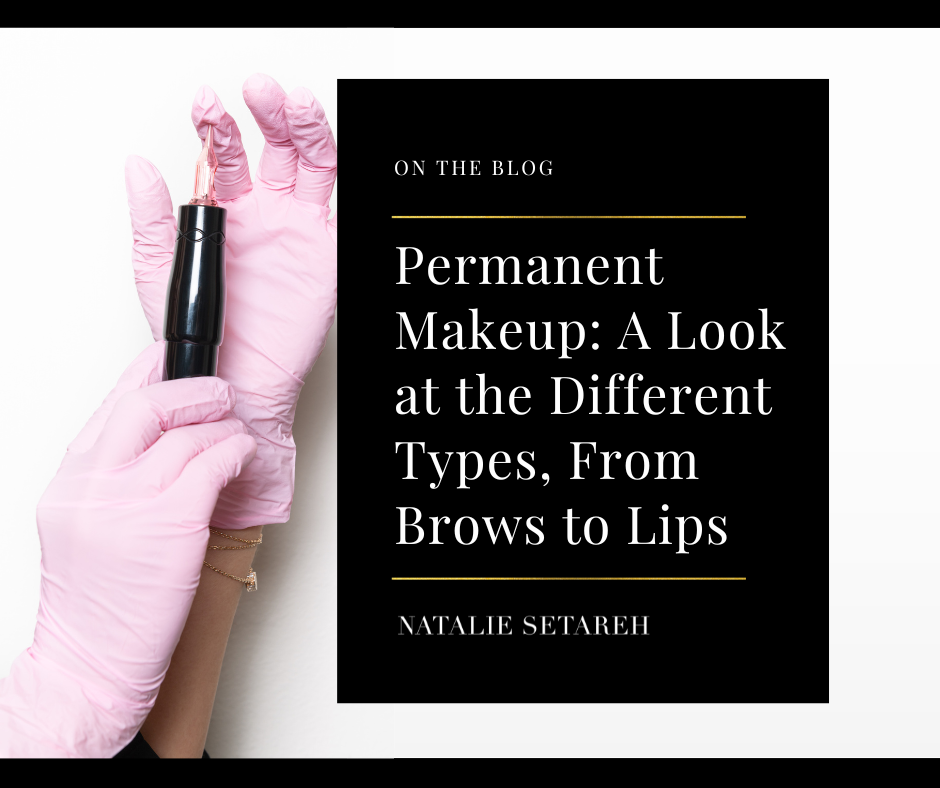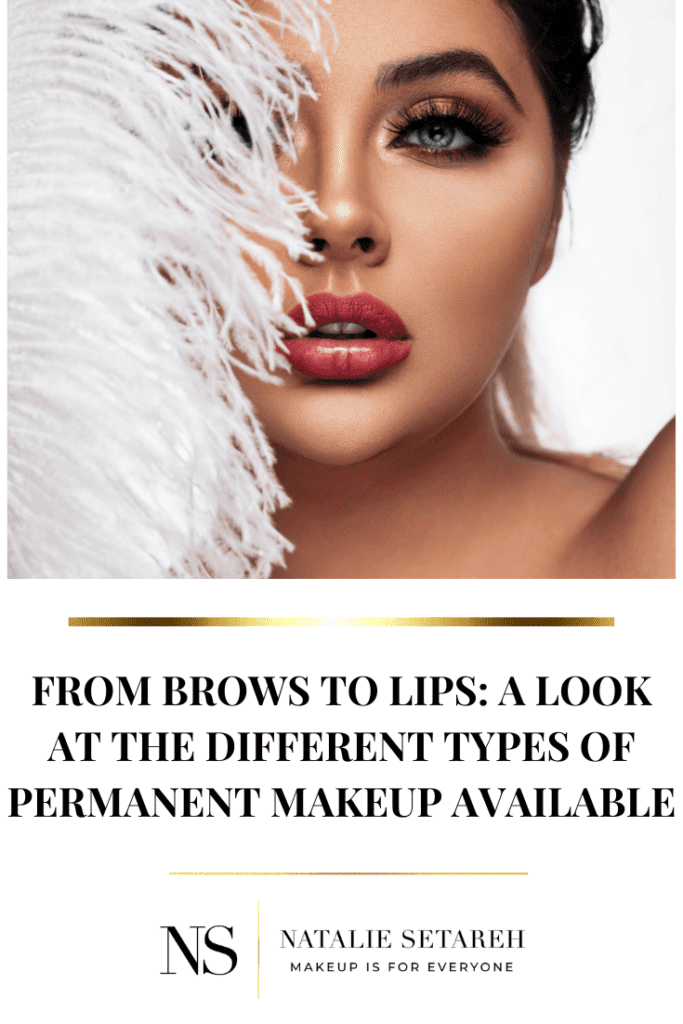
Imagine being able to wake up every morning with perfectly applied eyeliner, eyebrows, and lipstick! That’s what permanent makeup can do for you. In this post, I’ll share with you everything you need to know about making an informed decision about whether or not permanent makeup (aka PMU) is right for you.
Permanent Makeup Is Not Right For You If ___
If you aren’t already deeply familiar with makeup, your colors, and your skin type — you’ll want to learn the basics of makeup first before you meet with any permanent makeup artists. You’ll end up wasting lots of money and time in consultations and you may end up with a permanent tattoo that you aren’t happy with.
What Are Permanent Makeup Tattoos?
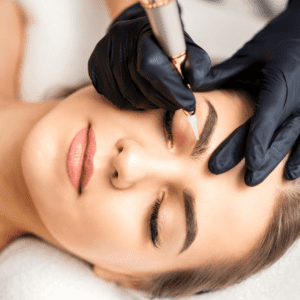
Permanent makeup, also known as cosmetic tattooing or micropigmentation, is a cosmetic procedure that is applied to the face and body to mimic the appearance of makeup. Please keep in mind, permanent makeup tattoos aren’t truly permanent. They last anywhere for 2-3 years, unlike normal tattoos which last a lifetime.
A permanent makeup artist (PMU artist) deposits ink into the epidermis (the top layer or surface of the skin). This layer is about 0.1 to 0.2 millimeters thick, so the needle doesn’t go very deep.
It’s a great option for people who want to save time in their morning routine, have trouble applying makeup due to vision or mobility issues, or just want to look fabulous 24/7!
Permanent Makeup Tattoo vs. the Traditional Tattoo?
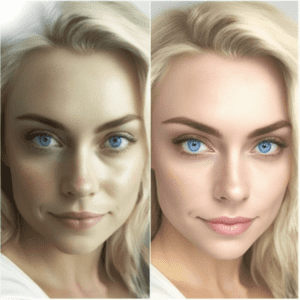
Difference 1: Depth
The main difference is the depth at which the needle goes into the skin.
With permanent makeup, the needle only goes into the epidermis, the outermost layer of skin, which is about 0.1 to 0.2 millimeters thick. Traditional tattoos go deeper, into the dermis, which is the layer of skin below the epidermis.
Difference 2: Ink
Permanent makeup tattoos use ink specifically formulated for use in the skin and ink that is more concentrated, allowing for more vibrant and long-lasting color.
Traditional tattoos use ink formulated for use on other surfaces.
And While We’re Talking About Ink…
Permanent makeup tattoo ink is made up of a variety of different ingredients, but the main component is pigments.
Just like pigments we find in our makeup and clothing, in terms of permanent makeup pigments are what give the ink its color.
These pigments can contain a variety of different materials, including:
- iron oxide
- titanium dioxide
- vegetable dyes
The ink also contains a carrier solution, which helps to keep the pigments suspended in the ink and helps to distribute the ink evenly when it’s applied. Carrier solution can contain a variety of different ingredients, most commonly:
- distilled water
- witch hazel
- ethanol
Important: not all inks are created equal. Some inks may contain harmful ingredients or ingredients you may be allergic to. I can’t emphasize this enough but do your research and find an artist who uses high-quality, safe inks.
Difference 3: Goals
The application of permanent makeup tattoos is generally used to enhance the features of the face like eyebrows, eyeliner and lips while traditional tattoos are used to make designs on any part of the body.
Difference 4: Longevity
Don’t let the name permanent makeup deceive you. Permanent makeup tattoos are actually semi-permanent. They last for 2-3 years.
As many of you know, traditional tattoos are considered permanent and can last a lifetime. So that’s why we want to think twice before getting an impulse tattoo next time you’re in Las Vegas! (wink, wink)
What About Microblading?
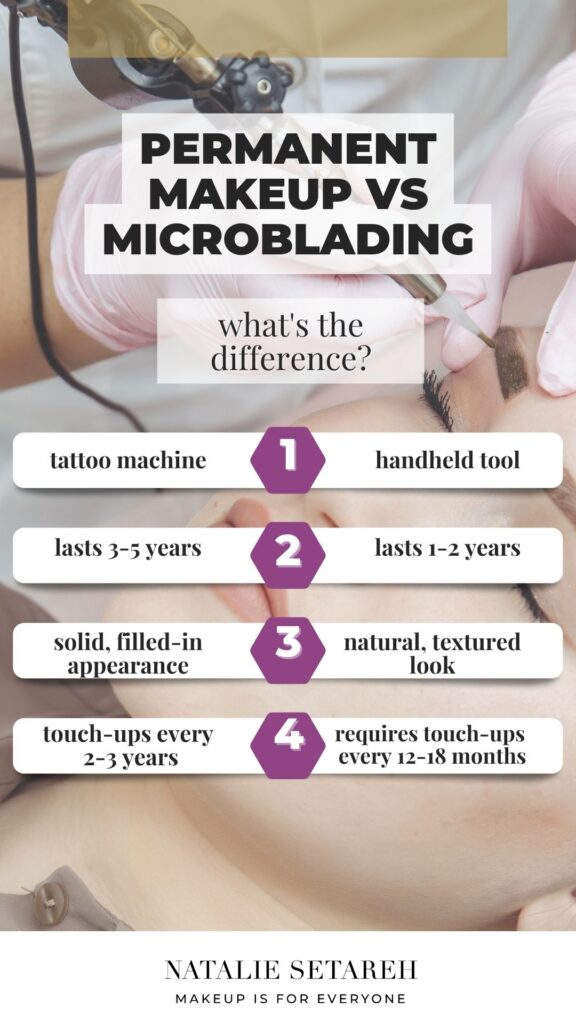
Where permanent makeup and microblading are both types of cosmetic tattooing, they are slightly different.
In permanent makeup, a tattoo machine is used to apply ink to the skin to mimic the appearance of makeup.
In microblading, a hand tool is used manually to create fine, hair strokes that mimic the look of natural hair. Think of it like drawing on your eyebrows with a pen, but instead of ink, it’s pigment that is being deposited into the skin. Microblading is also semi-permanent makeup and will require touch ups more often than in permanent makeup.
Both methods can give you amazing results, but it’s important to know the difference so you can choose the best option for you.
The Permanent Makeup Industry
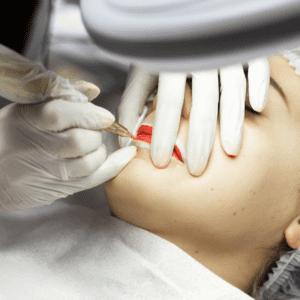
The permanent makeup industry has grown a ton over the last few years. More and more people are turning to permanent makeup as a way to save time, enhance their features, or even correct certain facial features. It’s becoming increasingly popular and accessible.
When Searching For A PMU Artist, consider their credentials.
This varies depending on where you live. In many places, it’s required that PMU artists have a cosmetology or esthetician license. Others may require specific training and certification in permanent makeup. When you know how this profession is regulated in your area, you’ll narrow down the pool for sure! A great place to start is a cosmetic doctor’s office!
The Society of Permanent Cosmetic Professionals (SPCP) is a professional organization that represents the interests of permanent cosmetic artists and technicians. The organization was founded in 1990 with the goal of promoting safety, education, and ethical standards in the industry.
To become a member of the SPCP, an individual must meet certain criteria. The first requirement is to have completed a formal training program in permanent cosmetics. This can include classes, workshops, or apprenticeships. The second requirement is to have completed a certain number of procedures, which varies depending on the level of membership. Learn More >
The International Institute of Permanent Cosmetics (IIPC) is an international organization that provides education, certification, and support to permanent makeup artists. They offer a variety of different training programs and certifications, and they also have a code of ethics that their members must abide by.
If you’re in the United States: There isn’t any specific organization that regulates PMU artists federally. However, each state has its own regulatory board, which oversees permanent makeup technicians, their licenses and qualifications.
Bottom Line: Before allowing anyone to tattoo your face, please check with your state’s regulatory board (if applicable) to know the specific regulations for permanent makeup practitioners in your area. It’s also important to look for an artist who has experience and a portfolio of their work. Do your research and find someone who has good reviews and a style that you like. And one who takes safety seriously and uses sterile equipment (obviously).
Is Permanent Makeup Right for Me?

Not all skin types are suitable for permanent makeup. People with oily skin or acne-prone skin may not be good candidates because the ink may not hold as well. Those with sensitive skin may also have a reaction to the ink. People with darker skin may also have a higher risk of complications.
On the other hand, people with dry skin or normal skin are generally good candidates for permanent makeup. If you are considering permanent makeup, it’s important to talk to a professional to determine if your skin type is suitable and what the risks are.
Not sure of your skin type? Take my skin care quiz to find out!
Permanent Makeup Procedures
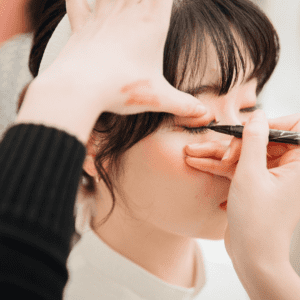
Keep in mind that just like traditional makeup, permanent varies based on your personal preferences. If you don’t know what your personal preference(s) are, you need to define that first. Fortunately for you, I touch on how to that here as well as inside of my Learn Makeup in 5 Days Course.
If you’re seriously considering permanent makeup but don’t know where to begin, consider starting with the area of your face that frustrates you the most but has the most impact.
For example, if there’s little to no contrast between your skin tone and your brow or lash color, then getting permanent eyebrows may be a great idea! Eyebrows frame the face and when you’re eyebrows are “done”, this creates high impact. However, many people struggle with doing their brows and doing them to appear naturally.
It’s important to really understand color theory and the various nuances of color interaction when selecting colors for your permanent makeup.
Permanent Eyeliner
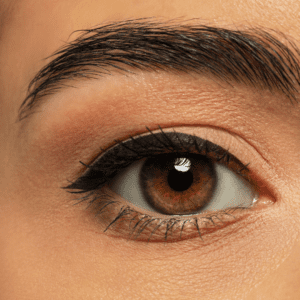
Permanent eyeliner is a popular cosmetic tattooing procedure that creates the appearance of a traditional eyeliner without the need for daily application. There are several different techniques and colors that are used for permanent eyeliner.
- Top eyeliner: This technique creates a line on the upper lash line, giving the appearance of thicker, darker lashes.
- Bottom eyeliner: This technique creates a line on the lower lash line, which can be used to create the appearance of thicker lashes or to make the eyes appear larger.
- Top and bottom eyeliner: This technique creates a line on both the upper and lower lash lines, giving the appearance of a complete eyeliner.
- Winged eyeliner: This technique creates a line on the upper lash line that is extended outwards, giving the appearance of a winged or cat-eye liner.
- Natural eyeliner: This technique creates a natural-looking eyeliner, often used to give the appearance of thicker lashes without the look of a traditional eyeliner.
In terms of colors, black and brown are the most popular choices for permanent eyeliner. But other colors like blue, green, grey, and purple are also used to create a unique look.
It’s important to note that the result of the eyeliner tattoo might vary based on the skill of the technician, as well as the quality of the ink and the tools used. It’s important to consult with a licensed and reputable professional to determine which technique and color would be best for your needs.
Lipliner/Lipstick Permanent Makeup

Permanent lip and lipliner services are popular cosmetic tattooing procedures that create the appearance of traditional lip color and lipliner without the need for daily application. There are several different services and colors that are used for permanent lip and lipliner.
- Lip tint: This service creates a subtle color on the lips, which can be used to enhance the natural color of the lips or to make them appear fuller.
- Lip blush: This service creates a more pronounced color on the lips, which can be used to create the appearance of a more defined lip shape.
- Full lip color: This service creates a more dramatic color on the lips, which can be used to create the appearance of a traditional lipstick.
- Lipliner: This service creates a line around the lips, which can be used to create the appearance of a more defined lip shape.
- Lip reshaping: This service is used to reshape the lips, making them look fuller or correcting any asymmetry.
In terms of colors, natural shades such as pink, red, and brown are popular choices for permanent lip and lipliner. But other colors like purple, orange, and black can also be used to create a unique look.
Permanent Eyebrow Makeup
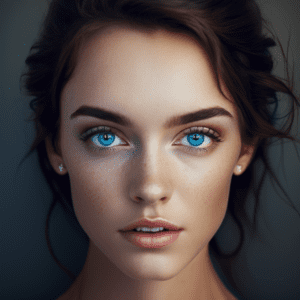
Permanent eyebrow services are popular cosmetic tattooing procedures that create the appearance of traditional eyebrows without the need for daily application. There are several different services and colors that are used for permanent eyebrows.
- Microblading: This service uses a hand-held tool to create hair-like strokes on the skin, creating the appearance of natural-looking eyebrows.
- Powder brows: This service uses a machine to create a powdery finish on the skin, giving the appearance of a filled-in eyebrow.
- Ombre brows: This service is a combination of microblading and powder brows, creating a gradient of color that gives the appearance of a natural-looking and filled-in eyebrow.
- Combination brows: This service is a combination of microblading, powder and ombré, creating a natural-looking and filled-in eyebrow.
- Hair stroke brows: This service uses a machine to create a hair-like strokes, mimicking the appearance of individual hairs.
Other Less Common Types of Permanent Makeup
Areola restoration Permanent Makeup: This is a special technique used to restore the appearance of the areola after breast surgery.
Scar Camouflage Permanent Makeup: There’s also scar camouflage, a technique used to minimize the appearance of scars on the skin.
Scalp Micropigmentation Permanent Makeup: There’s scalp micropigmentation, a permanent makeup technique used to give the appearance of hair on the scalp.
So, as you can see, there are many types of permanent makeup techniques. Each have its own unique benefits, you just have to choose the one that best suits your needs and preferences.
Alrighty, you’re thinking about getting permanent makeup and you want to know the good, the bad, and the ugly? Well, you’ve come to the right place. Let’s start with the good stuff, the advantages of permanent makeup.
Pros of Permanent Makeup
Great for busy bodies!
No more struggling to apply eyeliner or fill in your eyebrows. You literally “wake up this way!”
Great for people with vision or mobility issues!
Let’s face it, applying makeup well takes a more-or-less steady hand and a good eye. If you don’t have a steady eye or good eye but still want to put your best face forward and feel confident in makeup, this is a great solution.
Great for athletes or ‘wet’ professionals!
Basically if you find yourself sweating, showering, or swimming a lot as part of your work or leisure, permanent makeup is great! This don’t mean you can skimp on your skin care though but at least you’re makeup will be there!
Alternative to Plastic Surgery
Permanent makeup can enhance or correct certain facial features that you’re not happy with. This is a much better (cheaper and safer) alternative to going under the knife.
Cons of Permanent Makeup
Now, let’s talk about the not-so-good stuff, the disadvantages of permanent makeup.
You Can’t Change It
If you’re not 100% confident that you’re going to love the results, colors, or your appearance after the procedure, then you should probably hold off.
It Can Be Expensive
All our budgets vary and we all value money differently. But in general, prices for permanent makeup procedures can range from a few hundred dollars to several thousand dollars. This is definitely more costly than traditional makeup.
The most common procedures are eyebrows, eyeliner, and lips, and the prices for these procedures can range as follows:
- Eyebrows: Prices for eyebrow procedures can range from $300 to $800.
- Eyeliner: Prices for eyeliner procedures can range from $300 to $500.
- Lips: Prices for lip procedures can range from $400 to $800.
It’s important to note that these prices are only estimates. The actual cost of a procedure can vary depending on the location, the experience of the technician, and the type of procedure. Additionally, prices may vary based on the region you are in, some places may charge more or less.
It’s also important to note that many technicians offer discounts for additional sessions for touch-ups, which are usually required after the initial procedure to perfect the final result.
When it comes to PMU, you get what you pay for. Take time to research and choose a reputable, licensed professional to perform the procedure. And be prepared to invest in a quality service that is going to last you for a couple of years.
Chance of Infection
Also, there’s always a risk of infection and allergic reactions, so it’s important to do your research and find a reputable professional.
There’s a Risk of the Colors Being Off
And lastly, the color and shape of your tattoo may not turn out exactly as you imagined. Sometimes it may require touch ups or even removal.
In Summary
Permanent makeup is a semi-permanent cosmetic procedure to create the appearance of makeup. People use this to enhance features such as eyebrows, lips, and eyeliner.
It’s important that before doing any sort of permanent makeup procedure to know the risks and benefits.
Before investing in permanent makeup, I highly recommend learning traditional makeup application techniques and practices first. This will help you to fully understand the look you are trying to achieve with permanent makeup.
I hope this post was enlightening if this is something you’ve been considering. If you have questions for me or want to share your first-hand experience with PMU, please feel free to leave a comment on this post!
Stay beautiful,
Natalie
Beauty is about perception, not about make-up. I think the beginning of all beauty is knowing and liking oneself. You can't put on make-up, or dress yourself, or do you hair with any sort of fun or joy if you're doing it from a position of correction.
kevyn aucoin
